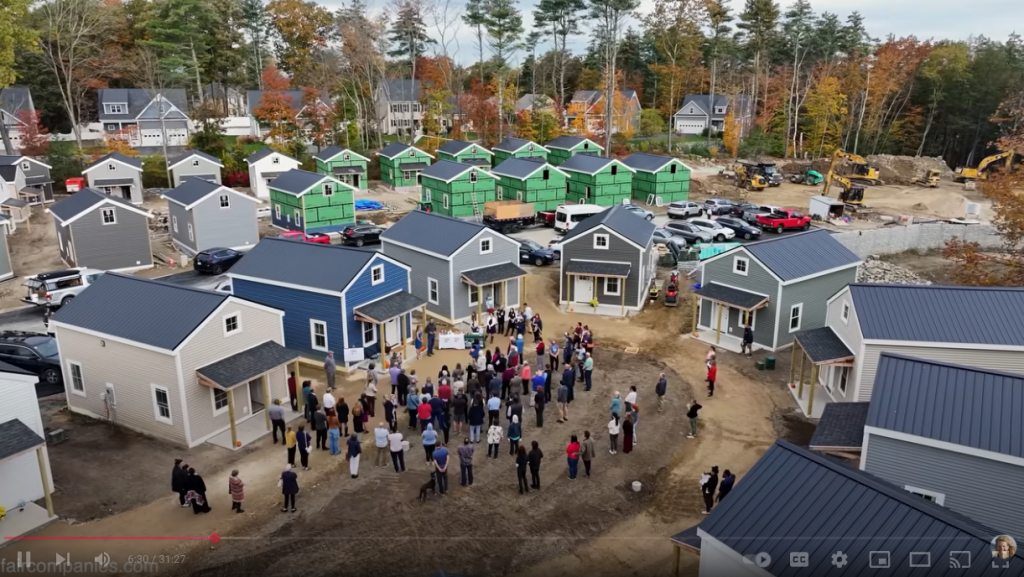I was just looking at this YT channel, because they posted an excellent video of the Montlake spite house a year ago, and noticed this feature about a New Hampshire grouping of cottages. See update below with added FAR comparison.
I think Bellevue residents would be really happy to see a project like the above in our neighborhoods. In a 2022 Bellevue survey with 567 respondents, cottage homes were the most popular housing type.
From the survey report, “Many commenters … would prefer to see small-scale, low-density options like duplexes or cottage homes built instead of these much larger scale single-family homes.”
Let’s take a look at the differences between the pocket village shown in the video and the proposed Bellevue rules for cottages.
Cottage height: These look like they’re about 16 feet tall, while Bellevue’s would be allowed to be 38 feet.
Cottage square footage: These are 384 sqft with a 160 sqft loft. Bellevue cottages are allowed to be 1750 sqft plus 300 sqft of bonus garage/unheated storage space that doesn’t count toward the FAR limit.
Open space and lot coverage: These have tons of open space. A common open space in Bellevue would only be required to be 15′ across, and if it’s a 15′ strip of a 75′ wide lot, that’s almost enough to satisfy the requirement for 12 units (100 sqft each).

Impervious area: Bellevue would allow 70% impervious surfaces, as long as 25% is porch area. This can bizarrely produce more walkways than needed and huge porches, that potentially account for more than half of the footprint of the buildings. In the common open area, 75% could be impervious rather than landscaped, possibly only allowing a 4-6′ strip of grass down the middle.
FAR: If we don’t count the greenbelt, this project has 44 units on about 4 acres. Counting the entire loft space toward the square footage, that means a FAR of 0.137, or one square foot of building interior space for every 7.2 sqft of the lot. In Bellevue, the FAR for cottages (on lots under 10k sqft) is 1.5, about 11 times as much, and each unit also gets a bonus 300 sqft to be used for parking/storage. Bellevue also allows each lot to have 2 ADUs that might not count toward the FAR limit (not sure what the outcome of the latest planning commission vote was).
I’ve tried to come up with cottage layouts, and it’s not always easy to use all the FAR and bonus space, even if you assume you have 4 story buildings that are build right up to the more generous middle housing setbacks.
Unlike other middle housing types which are limited to 6 units of middle housing + 2 attached ADUs per lot, there is no limit on the number of cottage homes on a lot, as long as you stay under the FAR cap. I think 12-16 on a 10,000 sqft lot is possible, and this gets particularly interesting when applied to half-acre lots, etc.
Porches: These have nicely sized porches that face the community space, but Bellevue will have no porch requirement. You could make just the minimum walkways needed and zero porches, so people would just go upstairs to hang out in their towers, which I don’t think would create a sense of community
Separation from neighboring properties: it looks like there’s a nice greenbelt with trees, whereas existing Bellevue homes could have cottages towering over them, just 5′ from the side of the property boundary.
Space for trees: Bellevue is creating a special loophole in the Tree Code. In many formerly single-family zones, there would be a requirement for 5 tree credits per 1000 sqft of lot area if you’re building a single family home and 4 tree credits when middle housing is built, except that cottages would only be required to have 1 tree credit per 1000 sqft of lot size. Ten tree credits are equivalent to two 14″ diameter trees on an entire lot, -or- five 6″ diameter trees -or- ten saplings with 2″ trunks.
In the interest of “tree health” there’s also going to be an allowance that gives out bonus tree credits as needed, so that middle housing developments don’t have enough space for trees to *ever* exist will get credit for more trees than they plant, allowing the developers to get out of paying into the fund to plant street trees because it would be so terrible (/s) if they had to buy the tree credits at $1350 a pop.
Leave a Reply